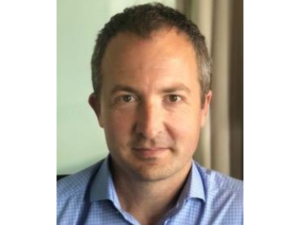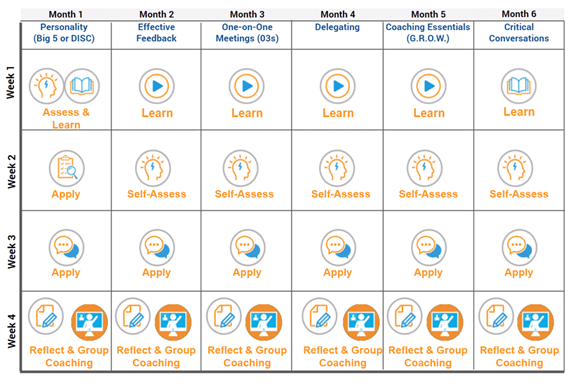
Duck Creek Technologies was founded in 2000 by a group of insurance experts from Ozark County, Missouri. Two of those insurance experts, Doug Roller and his brother John, grew up playing on Duck Creek, a creek that ran through their grandfather’s farm.
Duck Creek Technologies is a software-as-a-service (SaaS) company for property and casualty (P&C) insurance businesses. After its founding in 2000, Duck Creek grew rapidly, making Inc’s 100 fastest-growing companies list just five years later. Since then, the insurtech has grown to dominate the P&C insurance market and went public in August of 2020. By the time of the IPO, Duck Creek had about 1400 employees (whom they call Ducks) with its headquarters in Boston and other major office locations in Chicago, Bolivar (MO), and Mumbai.
Just five months later, in January of 2021, Darin Bond joined Duck Creek as their first corporate Learning & Development hire. He came on with a blank slate as there was no defined strategy for learning at the time. As their Sr. Manager of Learning & Development, it was his job to determine what to prioritize and why.

Duck Creek’s First Move: Exploring, Measuring, and Setting Priorities
Bond’s first move as Sr. Manager of Learning & Development was to intake as much data on the people and the culture as possible. He conducted a needs analysis, holding over thirty one-on-one conversations with senior leadership. In every meeting, he asked four key questions:
- What learning activity are you currently engaging in?
- What is your biggest priority for your leaders?
- What is your biggest priority for your individual contributors?
- What do you need for your own development?
His conclusion from all these meetings? Leadership development had to be their number one priority. Duck Creek was growing fast, which meant they had many new managers, many without any formal management training whatsoever.
Bond then sent out a survey to their 1600 employees asking about training priorities. The survey gauged both soft skills and technical skills. Based on the results, Bond had a set of ten topics that he knew were the most popular and important to employees. In May, Bond partnered with internal communications to formally kick off Learning4Ducks. It included the introduction of LinkedIn Learning, creating a centralized SharePoint site for all learning content, and launching a company-wide initiative to establish development goals for every Duck.
Introducing Development In The Flow of Work at Duck Creek
Duck Creek faced a challenge that is especially common at rapidly growing companies as they attempt to establish corporate learning for the first time: How would they win leaders’ attention, engagement, and time? Their leaders were busy and challenged in balancing their business priorities with their own professional development. Bond knew they needed to devise a system of learning that would enable them to level-set all managers, showing them what great leadership looked like. Bond didn’t want to ship managers off to an external retreat, pull them away from their work for a week, or drown them in learning that wouldn’t stick long-term.
To address this challenge, Bond, and his now growing team, delivered training in smaller segments, often through micro-learning. First, they launched a Glint 360 assessment for all of Duck Creek’s leaders. The results of the 360 helped each leader to understand their individual development priorities. And then used LinkedIn Learning to study the topics that would be the most relevant for their improvement.
Going Deeper with Development
The launch succeeded with flying colors. The Glint 360s in combination with LinkedIn Learning introduced leadership development to Duck Creek’s managers as something that was approachable, highly useful, and engaging. Many leadership development pros would have stopped at this point. But for Duck Creek, this was only the tip of the iceberg: “With how critical leadership is to organizational health, we couldn’t just settle for good leaders. We wanted to set a standard of ‘great leadership.’ We wanted a universal program that would get all leaders on the same page about what ‘great’ looks like on key behaviors like effective feedback, 1:1’s, coaching, and delegation.” Bond understood you couldn’t expect leaders to be doing the right things before you showed them how.
To establish these universal definitions and behaviors, Bond and his team wanted a solution that they could scale globally and fit into the flow of leaders’ schedules. They also wanted a solution that focused on practice and application on the job; not just learning and knowledge building. They built out a behavior- and application-focused program that followed a 3-to-1 model. Meaning for every single formal learning objective, leaders did three on-the-job application exercises. Their cadence was to cover one leadership topic per month.

Each week of the month consists of one on-the-job application exercise or learning. Bond also leveraged a flipped classroom model where leaders learned and applied each topic for three weeks. Then, during the fourth week, they met for a group coaching session to discuss key insights and work through specific challenges they faced as they applied and practiced what they learned.
The 3-to-1 approach to monthly leadership topics resonated incredibly well with Duck Creek’s leaders:
- 34% of leaders said it was the best workshop they’ve been a part of
- 78% said they communicate more effectively with their teams
- 90% felt more confident providing feedback
- 93% felt better equipped to hold one-on-one meetings
Making Time for Development a Formal Part of Ducks’ Jobs
Bond’s number one challenge and priority moving forward? “Time.” He broke it down as follows: “How do we carve out the necessary amount of time for development? If we're going to create a true learning culture, if we're going to offer LinkedIn Learning with 17,000 courses and do leadership development, and if we’re going to tell people about these great learning opportunities in recruiting and put it on our website as part of our culture, we better actually give employees the time to develop. If people start working here and they’re too busy to learn and grow, then we sold them a false promise.”
Bond plans to address this challenge by enabling employees to carve out an hour each week for learning and development. His plan is not just to “enable” development, but to make it a standard practice of the Duck Creek learning culture. “When talking with senior leaders to get buy-in on a specific initiative, I think it’s helpful to use figures they understand. For example, if we have 400 leaders who need to dedicate five hours a month toward development training multiplied by their average salary per hour, the cost is significant. If we are serious about growing our leaders, which I believe we are, we must agree that spending this money is worthwhile. It is an investment in Duck Creek’s future that will increase revenue and reduce costs from things like attrition.”
Bond’s Advice for Leadership Dev Pros: 1) Get to Know Your People, 2) Simplify Priorities, and 3) Find a Way to Reach Your Most Restricted Employees
1. Get to Know the People. “When you first come on board as a learning professional, spend a good amount of time assessing, asking lots of questions, meeting as many people as you can, and understanding what exists today. Of what already exists today, ask yourself ‘what works and what's not working?”
2. Simplify Priorities. Bond’s second piece of advice was to begin to build a realistic list of priorities to help you focus on doing fewer things better. “When I presented my plan to senior leadership, I gave them the three slides that surmised what my needs assessment showed me, what our priorities are, what I think our strategy should be, and what my next steps are from a 30-day, 60-day, 90-day period, and beyond.” He understood that overcommitting in the beginning and delivering sub-par solutions would damage the credibility and integrity of his strategy. Getting a few early wins gains trust and creates advocates across the organization.
3. Figure Out How to Reach Your Most Restricted Audience. If your program lands with your most hard-to-reach audience, it will likely land with those less restricted audiences too. In Bond’s case, the toughest audience was those who had billable hours and struggle to carve out dedicated time for training. Bond said, “If you're going to think about how to develop any kind of learning solution, and it's going be implemented across your entire organization, develop your pilot around the most restricted group possible. If it works for them, it'll work for everyone else.”







